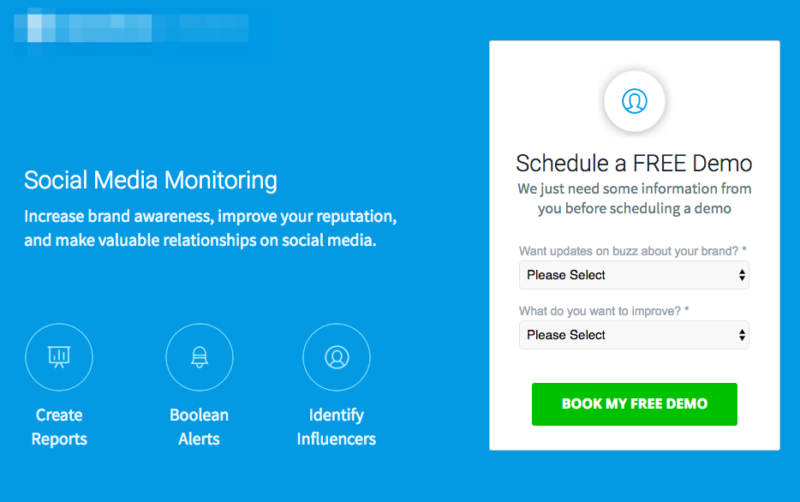Table of Contents
** Minutes
6 steps to optimize landing page performance
6 landing page tips and best practices
A well-designed landing page can do wonders for your business.
Your landing pages can be linchpins in paid and organic marketing campaigns that boost conversion rates and overall return on investment.
But it takes a lot more than picking out the right color or background image to convince your prospects to become leads and your leads to become customers. Online audiences have short attention spans and unlimited choices, so your landing pages need constant improvements to be effective.
And given that the top industry-wide conversion rate on Google Ads was below 8% in 2018, there’s definitely a lot of room for improvement. This guide to landing page optimization will show you how to build an optimized landing page, then improve conversion rates over time.
What is a landing page?
Landing pages are unique web pages designed to incite user action based on a conversion goal.
Unlike your home page, which functions as an information directory and brand representative for your business, effective landing pages. That job can vary wildly, from collecting lead information to making a sale.
Because they are limited in scope, landing pages are often purposefully limited in design as well. Most landing pages leave out potential distractions like a navigation bar and outbound links to keep the users’ attention on the task at hand.
What is landing page optimization?
Broadly speaking, landing page optimization is the process of making systematic changes to your website to improve your conversions.
Optimizing your landing pages most often involves testing specific variations to see if users engage more effectively with the update than they do with the existing page. At its best, optimization follows the scientific method: make an observation, pose a hypothesis, test your hypothesis, and draw a conclusion.
Why is landing page optimization important to my ecommerce business?
As an ecommerce seller, you’re probably investing budget in an online marketing campaign to drive visitors to your landing pages. If those pages don’t perform, you’re essentially leaving money on the table.
In contrast, optimized landing pages can lower customer acquisition costs, increase your return on investment, and even boost your rankings in Google Ad placements.
The intent of landing page optimization, like all forms of conversion rate optimization, is to improve performance based on measurable metrics. And landing pages are uniquely qualified to drive growth — a 2018 ecommerce study found that landing pages can engage and convert at a much higher rate than product detail pages.
6 steps to optimize landing page performance
Quick disclaimer: the bulk of your landing page decisions are going to be based on a) your audience and b) what you’re offering. That said, there are some basic rules that every landing page should follow to perform effectively and convert visitors.
1. Keep landing pages simple
We’ve already mentioned that landing pages should be limited to conversion-centric elements, but keeping the page simple is also important for keeping users engaged from beginning to end.
For example, a Baymard Institute ecommerce study found that 26% of shoppers abandoned their online carts because the checkout process took too long or was too complicated.
Completing a purchase, or any landing page conversion action, should be an enjoyable and seamless experience for your visitors. Confusing page components can drive your users away before they convert.
2. Use multiple calls to action that add value to the customer
The call-to-action (CTA) is the reason your landing page exists. It’s the decision point where your visitor must choose to act or to pass on your offer.
With that in mind, your CTA should be visible everywhere on your landing page. If your content and your CTA can fit ‘above the fold’ and your users don’t have to scroll, great. If your page is longer, however, repeat your CTA at least once per page length so that prospects will always be able to act, wherever they are on the page.
Finally, remember that optimizing your landing page CTA visually won’t do you any good if users don’t see value in your offer. If you’re asking for an email address in exchange for an eBook, for example, your user must believe that the value they’ll get from that eBook is worth more than keeping their email private.
3. Develop content that matches your keyword intent
If you’re targeting specific keywords with your ads, your landing page content should include those same specific keywords — preferably in a high-profile location like your headline.
A consistent and matching message assures your visitor that they’re in the right place, which helps to establish the trust you’ll need to convert. If users land on your page and don’t find what they expected when they clicked your ad, however, you’re wasting a little bit of their time and a lot of your money.
4. Persuade with social proof
Social proof is a powerful persuasive tool that adds credibility to your products and business. Many ecommerce sites provide social proof in the form of product reviews, but landing pages can also use rating systems, testimonials, trust icons, case studies and more. This effectively lets social commerce speak for itself and do the selling for you.
Relevant social proof can mean the difference between a conversion and an abandoned cart. Research shows that 55% of shoppers consider online reviews before making a purchase, and 72% of buyers will only take action after reading a positive review.
Also, don’t be afraid of a couple of bad reviews mixed in with the good — they make your feedback appear more authentic. In fact, a Revoo study found that customers who interact with bad reviews stay on site more than five times longer and convert at an 85% higher rate.
5. Ensure quick load times
Slow loading time is the silent killer of your landing page.
KISSmetrics found that 47% of online consumers expect a website to load in under two seconds, and a one-second delay in page response time can cause a 7% decrease in conversions.
A simple design is one surefire way to keep loading times down, but you should still perform regular load tests and website optimizations to make sure your existing landing page elements aren’t hurting performance. You don’t want to find out that your landing page isn’t capable of handling high traffic volumes during the holidays or in the final hours of a time-sensitive sale.
6. Be SEO-friendly
Landing pages are usually created as destinations for paid ads, not to appear in organic search engine results. But that doesn’t mean these pages can’t help your efforts to maximize overall traffic and conversion opportunities.
For example, some product or service website pages can be indexed for organic search and used for paid traffic. This won’t be true in every case, but you can use this technique to save on development costs while building your paid traffic and organic rankings. You can also share content and keyword data across paid and organic campaigns to improve targeting and build your brand.
6 landing page tips and best practices
Now that your landing page has an optimal foundation, there are a few more tips and tricks that you can put in place to ensure quality performance.
1. Track & analyze landing page data
It’s worth repeating: if you’re paying for clicks on Google Ads or another PPC network, every visit to your landing page costs you money. So if your landing page isn’t converting effectively, you’re going to need to figure out why.
That’s why setting up your landing page for tracking before your campaign begins is so important. If you can’t see basic details like your conversion rate, bounce rate, and other metrics, you won’t be able to learn from your efforts and make improvements.
In other words, if you don’t connect your landing pages to some version of analytics, you’re basically pouring money down the drain.
Don’t know where to start? Conduct a CRO audit to optimize your process.
2. Understand how your customer got to the page
With tracking in place, you can review where your traffic is coming from and how those channels affect your conversion rates. By segmenting your landing page traffic by source (known as “attribution” among analytics types), you can target your audience more effectively and improve conversions.
Understanding your visitors’ route to your landing page can also give you insights into their journey as a buyer. Traffic from social media, for example, might be interested in learning about your offer but not ready to convert, while someone who clicks on a paid ad is more likely to convert right away.
A great example is Housecall Pro, a software used by home service companies such as plumbers, HVAC technicians, and cleaning companies, who uses targeting by creating custom landing pages for each customer segment.
3. Test your landing page components
Once your landing page is up and running, you can start creating and testing different variations of the page to see if a different version converts more effectively. You can try different headlines, form sizes, types of social proof — the possibilities are endless.
Start with changes close to your purchase point that have high potential to impact your bottom line immediately. By starting at the end of your marketing funnel, you can optimize from the inside out, knowing that each incremental change will be optimized and reducing speculation and best guesses.
You’ll also need a minimum amount of traffic — QuickSprout recommends at least 10 conversion actions per day — to generate enough data for your tests to be worthwhile. Small sample sizes can lead you astray, so wait until your traffic levels are high enough to test properly.
4. Revisit your form fields
The way you ask for your users’ information can have just as profound an impact on conversions as anything else on your landing page.
When you’re creating your landing page form, conventional wisdom says that you should ask for as little as possible — just get what you need from your visitors and don’t burden them with too many questions.
This principle makes sense in theory, but at a deeper level it cuts off the human connection you should be establishing with your prospects. Asking for a user’s contact or payment information without a baseline of confidence and trust is like proposing marriage before the end of a first date.
We’ve found that more steps and form fields can actually increase landing page conversions — when you put them in the right order.
You can use additional questions to create multi-step forms that ‘guide’ prospects through your form to a completed conversion. Salespeople know this method as the “Yes Ladder,” but on landing pages, we call it the breadcrumb technique, like the breadcrumbs Hansel and Gretel used to find their way home.
The breadcrumb technique aims to get users to convert by starting with smaller, simpler requests that are easy to say “Yes” to. In the example below, we added some anonymous, low-pressure to the first stage of this landing page to hook the visitor:


Bonus tip: If you’re struggling to come up with first-stage questions, talk to your sales team to find out what they ask leads as part of the qualifying process, and adapt those questions to your form. This will also help you weed out unqualified leads and help your team use resources more efficiently.
5. Don’t be afraid to mess up
No matter how good your ideas are, the changes you make to your landing pages aren’t guaranteed to succeed.
For example, we thought an image of our client’s hair styler in action would convert better than an image of the product alone, so we tested that variation as part of their campaign:


The lesson: It’s not easy to make all of your landing page elements work in harmony, and messing up is part of the deal. Learning from your mistakes is just as important as learning from your successes.
6. Clarify shipping info
It’s happened to all of us — you’re ready to complete a purchase, you think you know how much it will cost, and then the tax and shipping costs pop in and throw your whole world out of whack.
It’s best to clearly state any shipping costs as early as possible in the checkout process so your users aren’t surprised. A Statista survey found that most shopping carts are abandoned because of unexpected costs.
If you’re creating landing pages for an ecommerce store, we recommend including shipping info on all pages and incorporating the expected delivery date for both throughout the checkout process.
And if you can, consider offering free shipping — 90% of consumers said free shipping was the top incentive that would encourage them to shop online more often.
3 top landing page optimization resources
By now you’ve probably realized two things: you need a lot more landing pages to reach your online audience effectively, and an awful lot of thought and effort goes into generating, testing, and optimizing landing pages that work.
If this process sounds daunting, don’t worry — there are plenty of tools that marketers can use to create and test landing page ideas. And if your marketing team needs help with campaign operations, there are experts available to take care of the day-to-day details.
1. KlientBoost
KlientBoost is a PPC and landing page design agency specializing in conversion rate optimization.
KlientBoost landing pages are built from scratch and rigorously tested by a team of designers and CRO professionals to grow conversion rates effectively.
If you’re building and testing your own landing page, KlientBoost also has an extensive library of optimization techniques and expert recommendations.
2. Unbounce
Unbounce is a content management and website hosting system that marketers use to generate, publish, and test landing pages for specific online advertising, email, and social media campaigns.
The Unbounce Landing Page Analyzer Tool evaluates landing pages that you create and provides custom recommendations based on the platform’s proprietary CRO experience and research, Google best practices, and more.
The analysis is based on data collected from almost 75 million visits to more than 64,000 Unbounce landing pages. The tool, which Unbounce offers for free, considers performance categories like SEO, mobile responsiveness, conversion centered design, and message match.
3. HubSpot
HubSpot is an online marketing authority that specializes in lead generation, automation, and analytics.
To use the HubSpot Landing Page Analysis tool you’ll have to create your page in HubSpot, but the system is set up with templates and an all-in-one, easy-to-use interface. Your landing page can display personalized content, CTAs, and forms based on visitor demographics and will be set up so you can test variants and see which converts more effectively.
Conclusion
At this point, you should have a decent understanding of what landing page optimization steps you should take, and how to create an optimized page from the ground up.
Before you go out there and take the online advertising world by storm, remember that your optimization work is never done. You’ll need to keep testing, keep refining, and keep improving to reach and convert your audience. And unlike “brand exposure” or “awareness” campaigns, you’ll be able to see measurable, significant results through higher conversion rates, more audience engagement, and higher return on investment.
Ready to partner with a 3PL like ShipBob? Request a quote today.



